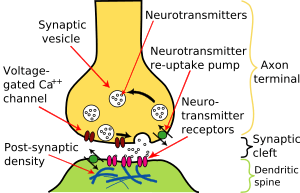Chemical synapse facts for kids
Chemical synapses are tiny gaps where neurons (nerve cells) connect and send messages to each other using special chemicals. Think of them as communication points in your brain and body. These synapses are super important for everything you do, from thinking and moving to feeling emotions.
Neurons are like tiny wires that carry electrical signals called action potentials. Your brain has billions of neurons, and they need to talk to each other to work. But these electrical signals can't just jump across the gap between neurons. That's where chemical synapses come in! They use chemical messengers called neurotransmitters to carry the signal from one neuron to the next. This is different from electrical synapses, which pass electrical signals directly.
How Chemical Synapses Work
A typical chemical synapse has three main parts that work together to send a message:
- The pre-synaptic terminal is usually at the end of the first neuron's axon (a long arm that sends signals). This part releases the chemical messengers (neurotransmitters) into the gap. "Pre-" means "before," so it's the neuron sending the signal.
- The synaptic membrane of the post-synaptic cell is on the next neuron, often on its dendrite (a branch that receives signals). This part has special spots that catch the neurotransmitters. "Post-" means "after," so it's the neuron receiving the signal.
- The synaptic cleft is the tiny space between the pre-synaptic terminal and the post-synaptic membrane. It's filled with a jelly-like substance that helps hold the two neurons close together.
When an electrical signal (action potential) arrives at the pre-synaptic terminal, it causes tiny sacs filled with neurotransmitters to release their chemicals into the synaptic cleft. These chemicals then float across the gap and attach to the post-synaptic membrane, passing the message along.
Two Main Types of Chemical Synapses
Chemical synapses can be grouped into two main types based on what they do to the next neuron:
- Type I Synapses (Excitatory): These are the most common type in your brain. They are like a "go" signal. When a Type I synapse sends a message, it usually makes the next neuron more likely to create its own electrical signal (action potential). These synapses often connect to the dendrites of the receiving neuron.
- Type II Synapses (Inhibitory): These synapses are like a "stop" or "slow down" signal. Instead of making the next neuron fire an electrical signal, they make it less likely to do so. They help control and balance the brain's activity, preventing it from getting too excited.
Images for kids
See also
 In Spanish: Sinapsis química para niños
In Spanish: Sinapsis química para niños





